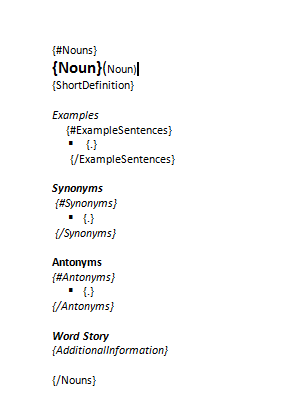Help Docs
Loops play a very important role in document generation. We use them to populate multiple line items in invoices, list conditions in contracts, etc. The following tutorial describes how to go about loops creation.
{#tagName}{/tagName} is the syntax for loops.
|
Role |
Company |
Address |
|
{#Job} {Role} |
{Company} |
{Address} {/} |
Below is the sample JSON file. The system populates the Job array into the Job table.
[ {
"Enter_Name": "Steve",
"Enter_Email": "[email protected]",
"Job": {
"Role": "Engineer",
"Company": "Cisco",
"Address": "SanJose"
},
{
"Role": "Engineer",
"Company": "Oracle",
"Address": "SanJose"
}
}
]
EDocGen also supports nested tables - table inside a table.
|
H1 |
H2 |
H3 |
H4 |
|
{#table1}{#table2}{#table3}{#table4}{t41} |
{t42} |
{t43} |
{t44}{/}{/}{/}{/} |
The corresponding JSON for this table population is
[{
"table1": [{
"table2": [{
"table3": [{
"table4": [{
"t41": "t41data",
"t42": "t42data",
"t43": "t43data",
"t44": "t44data"
}]
}]
}]
}]
}]You can create HTML tables in your documents by populating HTML snippet (Tag for HTML population is {>>cellstyle1}) from your data file. The tables in generated documents would have HTML styling and colors.
| H1 | H2 | H3 | H4 | H5 |
|---|---|---|---|---|
| R1C1 | R1C1 | R1C3 | R1C4 | R1C5 |
You can also color certain cells based on conditions. Ex: If Value>, show the cell color in red.
You can filter the rows of data that are going to be populated into your template. From the above JSON, let's say you want to populate only the row where the company name is "Oracle". Add the condition in your table as below to achieve that.
|
{#Job}{#Company =="Oracle"} {Role} |
{Company} |
{Address} {/}{/Job} |
Similarly, you can have boolean conditions, to avoid creating empty rows.
Similarly, you can use the loops to create lists, bullets, and pages, etc. Please see the template below.
Bullets
With EDocGen, you can easily create lists and it's very similar to loops. Let's assume you have a JSON in the following format.
[{
"Sample": [value1, value 2,value 3]
}]
And you want to create a list that looks like this.
You just need to include the following loop in your template to create this list.
{#Sample}
{/Sample}
EDocGen loop over the array to extract each of the values and present them in a bullet format. Similarly, you can create lists from Excel and XML data.
You can use the relevant tags for creating numbered lists in the same way.
Nested Bullets/Lists
Below is the syntax of tags for nested lists creation.{#states}
{#cities}
-{.}
{/cities}
{/states}
The corresponding JSON for it is
[{
"states": [{
"state": "state1",
"cities": ["City1", "City2", "City3"]
},
{
"state": "state2",
"cities": ["1", "2", "3"]
}]
}]

You can populate JSON file to create multiple pages within a single document. It produces a section for each noun.
Though this example is creating repeating sections, it's also creating multiple lists inside it. This is another case of the nested list.
{#ExampleSentences}
{/ExampleSentences}
[{
"Nouns": [{
"Noun": "Abasement",
"AdditionalInformation": "",
"Antonyms": ["dignify", "exalt", "honor"],
"ExampleSentences": ["Nasty adults sometimes abase others due to the abasement they themselves have face", "His form of abasement was calling people rude names", "Abusive husbands use abasement as a form of emotional abuse to keep a submissive wife under control"],
"Images": ["words/Abasement/abasement_1.jpg", "words/Abasement/abasement_2.jpg"],
"LongDefinition": "Humiliating, degrading or abasing someone or something",
"PartOfSpeech": "Noun",
"Pronunciation": "audioPronunciation/abasement.wav",
"ShortDefinition": "degradation or humiliation",
"Synonyms": ["debasement", "corruption", "debauchment", "degradation", "demoralization", "deprivation", "deterioration", "humiliation"],
"Thumbnails": ["thumbs/Abasement/abasement_1.jpg", "thumbs/Abasement/abasement_2.jpg"]
},
{
"Noun": "Abhor",
"AdditionalInformation": "",
"Antonyms": ["dignify", "exalt", "honor"],
"ExampleSentences": ["Nasty adults sometimes abase others due to the abasement they themselves have face", "His form of abasement was calling people rude names", "Abusive husbands use abasement as a form of emotional abuse to keep a submissive wife under control"],
"Images": ["words/Abasement/abasement_1.jpg", "words/Abasement/abasement_2.jpg"],
"LongDefinition": "Humiliating, degrading or abasing someone or something",
"PartOfSpeech": "Noun",
"Pronunciation": "audioPronunciation/abasement.wav",
"ShortDefinition": "degradation or humiliation",
"Synonyms": ["debasement", "corruption", "debauchment", "degradation", "demoralization", "deprivation", "deterioration", "humiliation"],
"Thumbnails": ["thumbs/Abasement/abasement_1.jpg", "thumbs/Abasement/abasement_2.jpg"]
}
]
}]